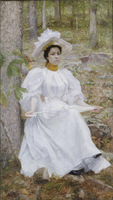 | Back to e-WV
| Back to e-WV
 The West Virginia Encyclopedia
The West Virginia Encyclopedia
 | Back to e-WV
| Back to e-WV
 The West Virginia Encyclopedia
The West Virginia Encyclopedia

Artist William Robinson Leigh (September 23, 1866-March 11, 1955) was a leading 20th-century painter and illustrator of the Old West. He was born in Berkeley County. Leigh studied at the Maryland Institute under Hugh Newell from 1880 to 1883, and at the Royal Academy in Munich, Germany, from about 1883 to 1892. Like David Hunter Strother, he sent letters home to West Virginia detailing his experiences abroad, which were published in the Martinsburg newspaper.
On returning to the United States, Leigh established a studio in New York, where he worked as an illustrator for Scribners Magazine. He spent the summer months during this period in Martinsburg, where he painted numerous landscapes and genre paintings, including West Virginia Woodchopper, Fishing in the Mill Pond, West Virginia Forest, and Loitering. He was also active locally as a portrait painter during this period. His life-size canvas of Sophie H. Colston (1896), now in the Smithsonian American Art Museum, is considered to be one of the masterpieces of late 19th-century American portraiture.
In 1906, influenced by Thomas Moran, Leigh took a train excursion with the artist Albert Groll to New Mexico. Enamored with the region and its inhabitants, he dedicated the bulk of his career to depicting the Old West on canvas. His idealism and photo realistic style were severely criticized by Eastern art critics at first, but Leigh eventually achieved broad national acclaim as one of the nation’s finest realist painters.
During the 1920s and 1930s, Leigh visited Africa with scientific safaris, organized by the American Museum of Natural History. He subsequently organized exhibits and painted backdrops for the Museum’s African Hall. Leigh was also an author of short stories. Several months before his death, he was elected to membership in the National Academy of Design.
Written by John A. Cuthbert